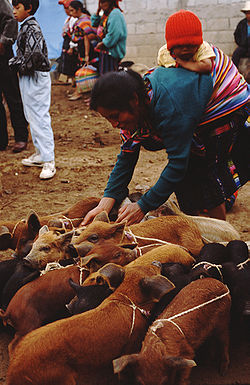Quiché (department)
Population
Quiché has historically been one of the most populous departments of Guatemala. At the 2018 census it had a population of 949,261. Mayans account for 88.6% of the department's population. Kʼicheʼ people are the largest Mayan ethnic group in the department, and account for 65.1% of the total population. The department is named after them.
While most of its indigenous population speaks the Kʼicheʼ (Quiché) language, other Mayan languages spoken in the department are Ixil (Nebaj - Chajul - Cotzal area), Uspantek (Uspantán area), Sakapultek (Sacapulas area), as well as Poqomchiʼ and Q'eqchi' in the northeast, bordering the Alta Verapaz department.
Geography
The topographical composition of Quiché is dominated by the central highlands and the mountain ranges of the Sierra de los Cuchumatanes, Sierra de Chuacús, and the foothills of the volcanic mountain range on the department's South-Western border with Chimaltenango, which together make up for 79% of the department's territory. The northern part of the department is formed by tropical lowlands which cover 21% of the department's territory.
The principal drainage basins in El Quiché are the Salinas, Motagua, Xaclbal and Ixcán river basins. The Salinas river basin (3668 km2), includes the Chixoy River which is a tributary of the Río Salinas and Río Usumacinta. The Motagua basin (1042 km2) includes the Río Grande which is an important tributary of the Río Motagua. The smaller Xaclbal (779 km2) and Ixcán basins (187 km2) are situated in the North-East of El Quiché. El Quiché has a small number of shallow lakes ("lagunas"): laguna de Lemoa and the laguna de La Estancia, both in Santa Cruz del Quiché, and the laguna de San Antonio in San Antonio Ilotenango.
Tourism

Places of interest in the department include the town of Chichicastenango and the ruins of Q'umarkaj. The department has several pre-colonial archeological sites, including Q'umarkaj (near Santa Cruz del Quiché), Pascual Abaj (in Chichicastenango), Cerro de San Andrés (in San Andrés Sajcabajá), Chutixtiox (near Sacapulas), Los Cerritos and La Laguna (in Canillá). Most of these sites are used as ceremonial centers in the Maya religion.
A regional museum can be found in Chichicastenango and Nebaj.
Though not as well known as the Santo Tomás church in Chichicastenango most other towns in the department have catholic churches dating from the colonial era.
The Visis Cabá biosphere reserve (450 km) is the only protected natural reserve in El Quiché. It is located in the North of Chajul, on the communal lands of the Ixil communities. The creation of protected natural reserves is being considered for El Amay in Chicamán and La Vega del Zope in Chinique.
Crime
Crime in the Quiché department is low, the homicide rate of 3 per 100,000 people is more akin to Western Europe than to the Guatemalan region in general.
Municipalities
The department is divided into 21 municipalities:
- Canillá
- Chajul
- Chicamán
- Chiché
- Chichicastenango
- Chinique
- Cunén
- Joyabaj
- Nebaj
- Sacapulas
- Patzité
- Pachalúm
- Ixcán
- San Andrés Sajcabajá
- San Antonio Ilotenango
- San Bartolomé Jocotenango
- San Juan Cotzal
- San Pedro Jocopilas
- Santa Cruz del Quiché
- Uspantán
- Zacualpa
References
- ^ Citypopulation.de Population of departments in Guatemala
- ^ "CARACTERIZACIÓN" (PDF). Ine.gob.gt. Retrieved 12 October 2017.
- ^ "Estrategia de reducción de la pobreza departamental, 2003 - Quiché". SEGEPLAN.
- ^ The tropical lowlands are located in the northern part of the municipalities of Chicaman, Uspantán and Chajul. "Estrategia de reducción de la pobreza departamental, 2003 - Quiché". SEGEPLAN.
- ^ "Cuencas Hidrográficas- El Quiché". Instituto Nacional de Bosques (INAB). Archived from the original on 2007-07-16. Retrieved 2008-05-25. See also "Mapa de Cuencas y Ríos". INSIVUMEH.
- ^ "Guatemala: Opposition to highway project threatening forest area". WRM's bulletin Nº 58, May, 2002. Archived from the original on 2007-12-17. Retrieved 2008-05-16.
- ^ The Visis Cabá biosphere reserve, also known as Biósfera Ixil, is located in the North-East of Chajul, on the communal lands of the Ixil communities. See also Romeo Tiu López. "Mayan Spirituality and Lands in Guatemala" (PDF). Arizona Journal of International & Comparative Law, vol 211, 2004 (University of Arizona). Archived from the original (PDF) on September 9, 2006.
- ^ Valencia, Roberto (15 Oct 2018). "Guatemala: el brutal castigo con el que la ciudad de Chichicastenango previene los homicidios en la región con más homicidios del mundo" [Guatemala: the brutal punishment with which the city of Chichicastenango prevents homicides in the region with the most homicides in the world]. BBC. Archived from the original on 15 October 2018. Retrieved 15 Oct 2018.
External links
![]() Media related to Quiché Department at Wikimedia Commons
Media related to Quiché Department at Wikimedia Commons

